Drainage pipes for sewage: we design a high-quality system
Preparing for the modernization of the sewage system in the apartment or designing this engineering network for the construction of a country house, first of all, you should decide which pipes to drain the sewage will be used. Not only reliability and durability depends on it, but also the price you spend on the purchase of materials.
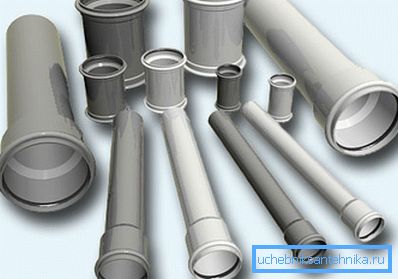
Requirements for the drain pipes
These products must have the following parameters:
- Longevity - A failed pipe causes a lot of trouble. It is a source of unpleasant odors and infectious diseases.
- Good bandwidth - it is not only difficult but also very unpleasant to get rid of the sewer blockage that has formed.
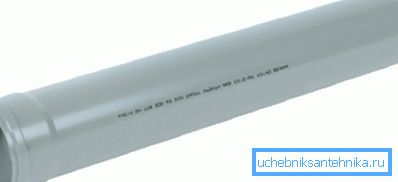
We list the main nuances that should be considered when choosing pipes for the construction of sewage systems:
- smoothness of the inner surface;
- small weight;
- resistance to low and high temperature;
- ease of installation;
- the cost.
Varieties of drainage systems
Sewerage in an apartment or a private house is used to remove dirty water from sanitary and residential premises.
There are three main types of drainage systems:
- internal (for example, draining the bath into the sewer);
- external (it includes sewage discharge in a private house, that is, that part of the pipeline that goes to the accumulation tank or septic tank);
- storm water
Not so long ago, all such engineering networks were designed and constructed only from concrete, ceramic or, more rarely, cast iron pipes.
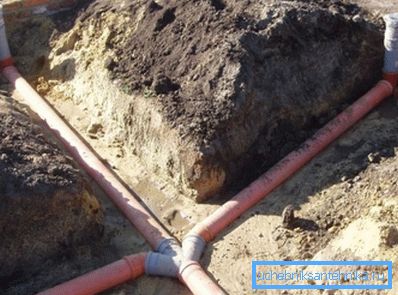
But recently, a lot of new and technologically advanced materials have appeared that have indisputable advantages:
- non-corrosive due to electromechanical effects;
- they have a smooth inner surface, as a result of which the coefficient of friction decreases and the chance of blockages is reduced;
- easy to install without the use of special equipment drainage network (can be made with your own hands within 1-2 days);
- cost much less metal products.
Types of pipes
Cast iron
This material, as mentioned above, has long been used for the manufacture of sewage, due to the following characteristics of iron:
- durability;
- strength.
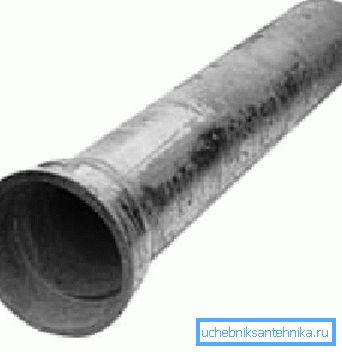
But such pipes have a rather impressive weight and cost, which increases the cost of installing the entire system. In addition, the inner surface of the cast iron product has roughness, which create obstacles for flowing water. As a result, growths are formed inside, which, over time, lead to a complete blockage of the system and the need for costly repairs.
Note! For the installation of sewage from cast iron pipes may require the use of special engineering equipment and electric welding. Therefore, it is better not to use this material for the independent manufacture of a sewer system.
Plastic
Plastic pipes are the best solution for designing a sewage drainage network from a dwelling. They can be used for installation of systems both indoors and outdoors. In addition, certain types of piping are used to connect various plumbing fixtures and household appliances.
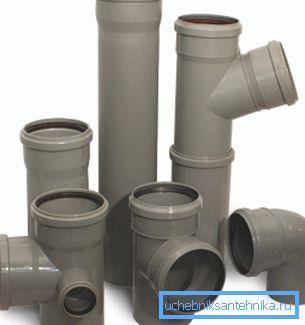
The advantages of this material are obvious:
- Smooth inner surface. Avoids the formation of blockages during the passage of wastewater in the finished sewer system.
- Low weight. It is good for both transportation and installation.
- Easy installation. To connect the pipes there is no need to use welding equipment or mortars. You just need to insert the end of one pipe into the socket of the other, and the rubber sealing ring there will provide the necessary tightness. Fittings are used for bends, turns and connections of plumbing devices.
- Long service life. Some manufacturers guarantee up to 50 years of operation of the finished sewer system.
Note! Technical characteristics of plastic pipes allow you to create a neat, compact and aesthetic drain system. If necessary, the pipeline can be hidden in a wall and plastered. Do not worry about the tightness of the connections.
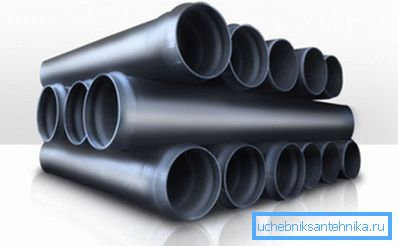
There are several types of plastic pipes.
| Material | Description |
| Polyvinyl chloride | Pipes are widespread for arranging gravity-type sewers. They are not subject to the negative effects of direct sunlight and have a small coefficient of linear expansion under the influence of hot water. This material is not destroyed by the flow of water, the temperature of which reaches 70 degrees Celsius. But there is a danger of destruction of the sewer system under the influence of aggressive chemicals and synthetic detergents. |
| Polyethylene | Used to construct internal and external sewer systems. The disadvantage of this material is a small temperature range of operation (from - 40 to +40 degrees Celsius). Therefore, the use of polyethylene in sewer systems designed to divert hot water is impossible. |
| Polypropylene | It is well tolerated by various chemicals. It is advisable to equip a dishwasher with a polypropylene pipe to drain the dishwasher down the drain, as well as the drainage system from the washing machine. They are durable, so they are practically not subject to mechanical damage. The temperature of the flowing fluid is up to 100 degrees Celsius. |

Storm sewer
Another type of sewage - stormwater. This type of drainage is equipped on country land plots. Instructions for laying the system requires the use of special pipes - flexible and corrugated.
They are made of two layers of plastic and have the following advantages:
- flexibility;
- ring strength.
As a result, the products withstand heavy loads, and during installation, the number of fittings required to assemble a complete system is reduced.
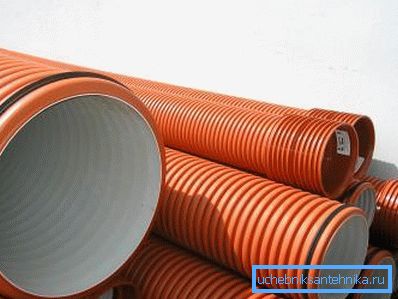
Note! Pipes for arranging internal and external sewage systems are easy to distinguish by color. The first are painted in gray, the second - in brown. Do not join two different systems without the use of special adapters. Otherwise, the tightness of such a node is not guaranteed.
Conclusion
The choice of material for the sewer system - perhaps the most important stage in its creation. For more information about this, see the video in this article.